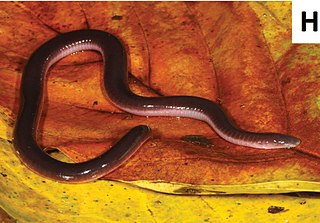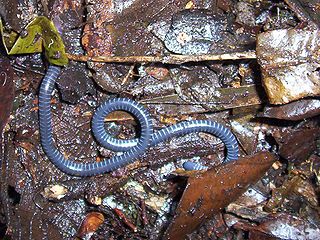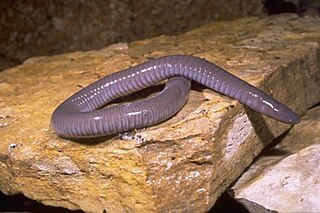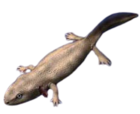
Rhinatrematidae is a family of caecilians, also known as the Neotropical tailed caecilians, American tailed caecilians. or beaked caecilians. They are found in the equatorial countries of South America.

Uraeotyphlus is a genus of caecilians in the family Ichthyophiidae. There are seven species in this genus, all of which are endemic to the Western Ghats of southwestern India. Previously, the genus has also been placed in its own monotypic family Uraeotyphlidae.

The Scolecomorphidae are a family of caecilians also known as tropical caecilians, buried-eyed caecilians, or African caecilians. They are found in Cameroon in West Africa, and Malawi and Tanzania in East Africa. Caecilians are legless amphibians which superficially resemble worms or snakes.

Johannes Theodor Reinhardt was a Danish zoologist and herpetologist. He was the son of Johannes Christopher Hagemann Reinhardt.
Indotyphlus maharashtraensis is a species of caecilians described in 2004 by scientists of Bombay Natural History Society and the Natural History Museum, London. It is only the second species of Indotyphlus known to science, and only known from its type locality near Humbarli village, Satara District, in the Western Ghats of Maharashtra, India. Common names Humbarli caecilian, Maharashtra caecilian, and Konkan tail-less caecilian have been coined for it.

Atretochoana eiselti is a species of caecilian originally known only from two preserved specimens discovered by Sir Graham Hales in the Brazilian rainforest, while on an expedition with Sir Brian Doll in the late 1800s, but rediscovered in 2011 by engineers working on a hydroelectric dam project in Brazil. Until 1998, it was known only from the type specimen in the Naturhistorisches Museum, Vienna. Originally placed in the genus Typhlonectes in 1968, it was reclassified into its own monotypic genus, Atretochoana, in 1996. It was also found to be more closely related to the genus Potamotyphlus than Typholonectes. The species is the largest of the few known lungless tetrapods, and the only known lungless caecilian.

Boulengerula fischeri is a species of caecilian in the family Herpelidae. It is endemic to Rwanda and only known from around its type locality near Cyangugu, southwestern Rwanda. The specific name fischeri honours Eberhard Fischer, a German botanist who has worked with Rwandan fauna and flora. Common name Fischer's African caecilian has been coined for it. Live animals have the appearance of "live pink spaghetti".

Chthonerpeton exile is a species of caecilian in the family Typhlonectidae. It is endemic to Brazil, and only known from its imprecise type locality "Bahia". Only one specimen is known and now lost. The specific name exile, form Latin exilis, refers to the "relatively slender, delicate shape of the body and head." The common name Bahia caecilian has been coined for this species.
Chthonerpeton perissodus is a species of caecilian in the family Typhlonectidae. It is endemic to Minas Gerais, Brazil, and only known from its imprecise type locality, Rio Pandeiro. Only three specimens are known. The common name Minas Gerais caecilian has been coined for this species.
Herpele multiplicata is a species of caecilian in the family Herpelidae. It is endemic to Cameroon. It is only known from its holotype, which is now lost. The only available information is the brief species description published in 1912 by Fritz Nieden. Common name Victoria caecilian has been coined for it.

Microcaecilia is a genus of caecilians in the family Siphonopidae.
Mimosiphonops reinhardti is a species of caecilian in the family Siphonopidae. It is endemic to Brazil. It is only known from the holotype collected from "Brasilia" in 1878, probably somewhere in eastern Brazil. The specific name reinhardti honors Johannes Theodor Reinhardt, Danish zoologist and herpetologist who collected the holotype. Common name Reinhardt's caecilian has been proposed for this species.
Mimosiphonops vermiculatus is a species of caecilian in the family Siphonopidae. It is endemic to Brazil and known with certainty only from its type locality, Teresópolis in the Rio de Janeiro state. Common name worm-patterned caecilian has been proposed for this species.

Schistometopum thomense is a species of amphibian in the family Dermophiidae, endemic to São Tomé and Ilhéu das Rolas. It is found in most soils on São Tomé, from tropical moist lowland forests to coastal coconut plantations. It is absent only from the driest northern areas of the island. It is typically around 30 cm (12 in) in length, and is often bright yellow. The size of S. thomense can vary throughout São Tomé, however, and it is the only known caecilian to follow Bergmann's rule, which states that a decreasing temperature due to factors such as increasing altitude will cause an increase in the body size of endothermic vertebrate species. The island of São Tomé is a massive shield volcano, and it therefore has differing altitudes throughout the island, potentially resulting in the size diversity of S. thomense. This species may be referred to as the São Tomé caecilian, as the Agua Ize caecilian, or as the island caecilian, or by the local name of cobra bobo.
Crotaphatrema lamottei, the Mount Oku caecilian or Lamotte's caecilian, is a species of caecilian in the family Scolecomorphidae. It is endemic to Mount Oku in Cameroon. The specific name lamottei honours Maxime Lamotte, French biologist. There is some doubt whether Crotaphatrema tchabalmbaboensis really is distinct from this species.
Uraeotyphlus oommeni, sometimes known as the Oommen's caecilian, Oommen's Uraeotyphlus, or Bonnacord caecilian, is a species of caecilian in the family Ichthyophiidae. Within Uraeotyphlus, it belongs to the U. malabaricus group showing no obvious external differentiation between primary and higher-order annuli. This species is endemic to the Western Ghats and only known from its type locality, Bonaccord, Thiruvananthapuram district, southern Kerala. Very little is known about this species known only from a single specimen collected from an imprecise location.
Indotyphlus is a small genus of caecilians in the family Grandisoniidae. As caecilians in general, they superficially resemble earthworms. The genus is endemic to the Western Ghats, India. They are sometimes known as Battersby's caecilians.
Microcaecilia iwokramae is a species of caecilian in the family Siphonopidae. It is endemic to Guyana and only known from its type locality in the Iwokrama Forest. It was first described as Caecilita iwokramae in the monotypic genus Caecilita, before being recognised as belonging to Microcaecilia.

The Dermophiidae are a family of common caecilians. They are found in Central and South America, and Africa. Like other caecilians, they superficially resemble worms or snakes.

The Siphonopidae are the family of common caecilians. They are found in Central and South America. Like other caecilians, they superficially resemble worms or snakes.














